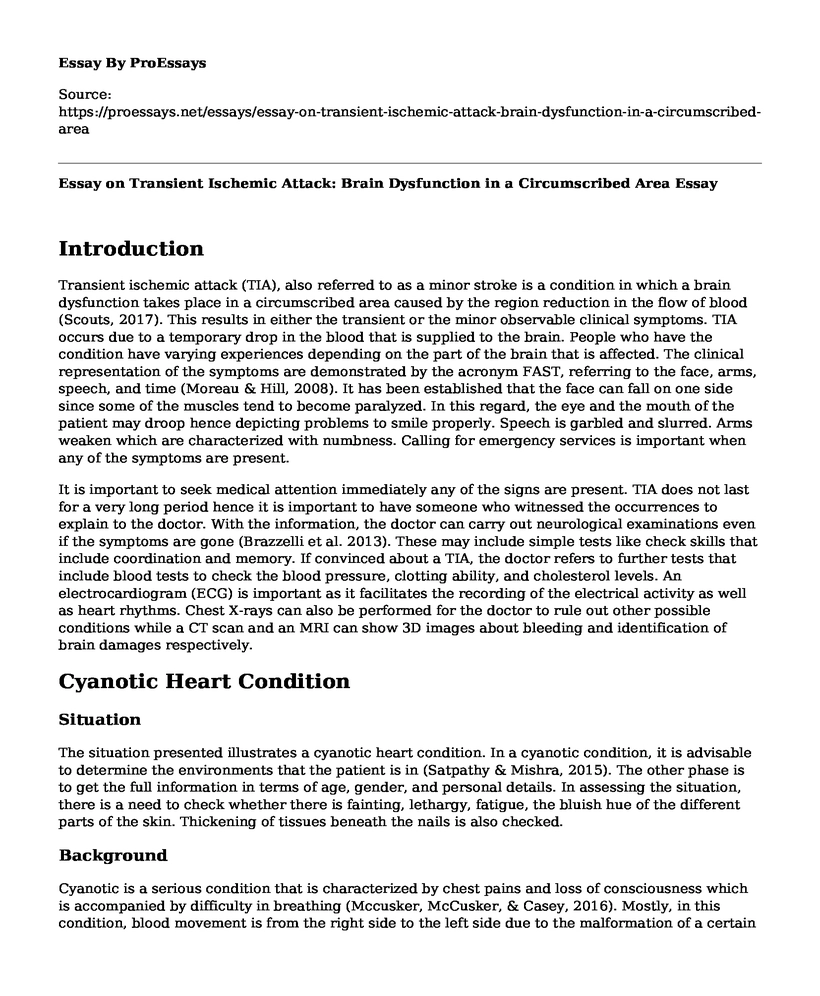Introduction
Transient ischemic attack (TIA), also referred to as a minor stroke is a condition in which a brain dysfunction takes place in a circumscribed area caused by the region reduction in the flow of blood (Scouts, 2017). This results in either the transient or the minor observable clinical symptoms. TIA occurs due to a temporary drop in the blood that is supplied to the brain. People who have the condition have varying experiences depending on the part of the brain that is affected. The clinical representation of the symptoms are demonstrated by the acronym FAST, referring to the face, arms, speech, and time (Moreau & Hill, 2008). It has been established that the face can fall on one side since some of the muscles tend to become paralyzed. In this regard, the eye and the mouth of the patient may droop hence depicting problems to smile properly. Speech is garbled and slurred. Arms weaken which are characterized with numbness. Calling for emergency services is important when any of the symptoms are present.
It is important to seek medical attention immediately any of the signs are present. TIA does not last for a very long period hence it is important to have someone who witnessed the occurrences to explain to the doctor. With the information, the doctor can carry out neurological examinations even if the symptoms are gone (Brazzelli et al. 2013). These may include simple tests like check skills that include coordination and memory. If convinced about a TIA, the doctor refers to further tests that include blood tests to check the blood pressure, clotting ability, and cholesterol levels. An electrocardiogram (ECG) is important as it facilitates the recording of the electrical activity as well as heart rhythms. Chest X-rays can also be performed for the doctor to rule out other possible conditions while a CT scan and an MRI can show 3D images about bleeding and identification of brain damages respectively.
Cyanotic Heart Condition
Situation
The situation presented illustrates a cyanotic heart condition. In a cyanotic condition, it is advisable to determine the environments that the patient is in (Satpathy & Mishra, 2015). The other phase is to get the full information in terms of age, gender, and personal details. In assessing the situation, there is a need to check whether there is fainting, lethargy, fatigue, the bluish hue of the different parts of the skin. Thickening of tissues beneath the nails is also checked.
Background
Cyanotic is a serious condition that is characterized by chest pains and loss of consciousness which is accompanied by difficulty in breathing (Mccusker, McCusker, & Casey, 2016). Mostly, in this condition, blood movement is from the right side to the left side due to the malformation of a certain component of the heart. Evaluation of the history of the patient's condition like, how often does it occur, and if the patient has been subjected to any medication before the response team arrival is imperative.
Assessment
Oxygen therapy might be the first action and warming up of the affected areas then, test the blood pressure and the oxygen levels of the blood. It could be carried out through blood draws and pulse oximeters. A complete blood test helps verify the type of cyanotic heart disease present. Cardiovascular catheterization is performed to place a small tube from the groin into the right or left valve of the heart as well as the application of MRI.
Recommendation
After evaluating the type of cyanotic defects, in a case where it might be severe and won't heal in time, open heart surgery might be performed. During the patients' recovery process, it is advisable for the patient to live a stress-free life, quitting any unhealthy lifestyles such as smoking and drinking. Regular check-ups are vital until the disease is eliminated in the blood of the victim.
References
Brazzelli M, Shuler K, Quayyum Z, et al. (2013). Clinical and imaging services for TIA and minor stroke: results of two surveys of practice across the UK. BMJ Open, 3(8) doi:10.1136/bmjopen-2013-003359.
Mccusker, C., McCusker, C., & Casey, F. (2016). Congenital heart disease and neurodevelopment: Understanding and improving outcomes. London: Elsevier Academic Press.
Moreau, F., & Hill, MD. (2008). Transient ischaemic attack is an emergency: think about best current stroke prevention options. International Journal of Stroke, 3(4), 251-253. doi:10.1111/j.1747-4949.2008.00225.x.
Satpathy, M., & Mishra, B. R. (2015). Clinical diagnosis of congenital heart disease. New Delhi: Jaypee/The Health Sciences Publisher.
Scouts, S. (2017). Diagnosis and management of Transient Ischemic Attack. Continuum, 23(1), 82-92. doi: 10.1212/CON.0000000000000424
Cite this page
Essay on Transient Ischemic Attack: Brain Dysfunction in a Circumscribed Area. (2023, Feb 11). Retrieved from https://proessays.net/essays/essay-on-transient-ischemic-attack-brain-dysfunction-in-a-circumscribed-area
If you are the original author of this essay and no longer wish to have it published on the ProEssays website, please click below to request its removal:
- The Kaplan-Meier Method
- Some Questions on Deaf and Hard Hearing People
- Reflective Essay on Volunteerism in Hunger Resource Center
- Assessment of Population Needs, Assets and Capacities Affecting Communities' Health
- Essay Example on Rise of E-Cigarettes: A Safer Alternative to Traditional Smoking
- Essay Sample on Master of Social Work: Pursuing a Career in Care Specialist
- Diabetes Mellitus: Type 1 Overview & Stats - Essay Sample







